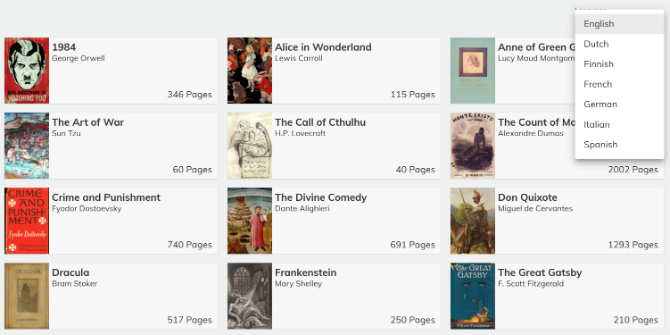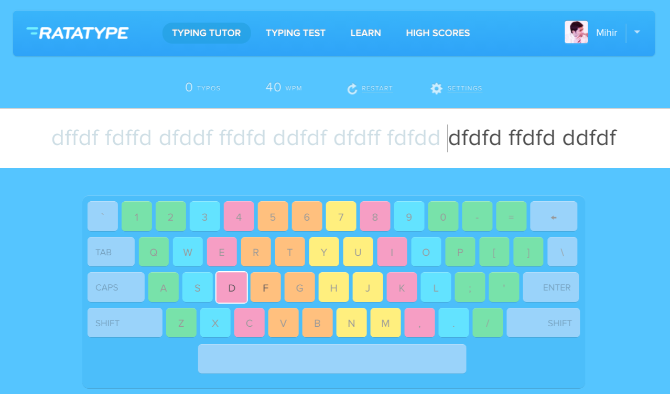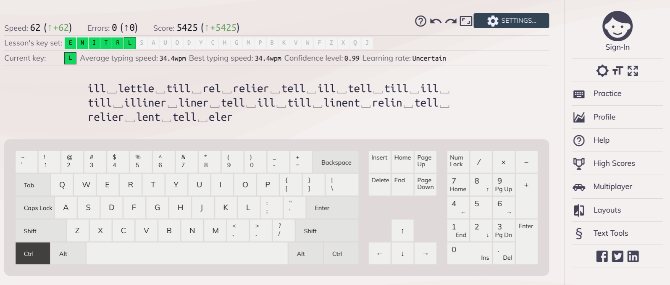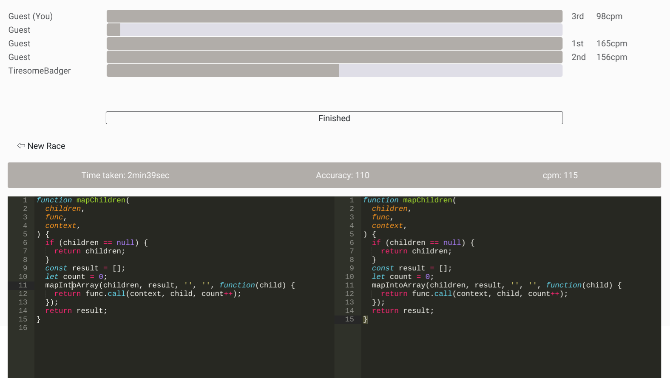If you're still looking at your keyboard when you type, you're doing it wrong. It's time to learn touch typing to increase your speed as you look at the screen to write faster.
Most jobs in the modern world will need you to type at a computer screen for hours; it's not just writers who need to know how to type fast. And you'll want to chat online at speed too. If you're already pretty quick, you can test your speed with online multiplayer typing games. And once you realize you could do better, these websites will teach you how to touch-type faster.
1. Typelit (Web): Read Classic Literature and Practice Typing Simultaneously
As you probably know, many books of classic literature are in the public domain today, and anyone can download these free books. Typelit uses these free classics to help you learn how to type at a fast speed, while also reading great books.
The library shows the chosen classics and how many pages each book is. Click the one you want to read, and type along. You need to get all the capital letters, punctuation, and spaces right. The test calculates your speed and accuracy per page, displayed after you finish a page.
Everything you type correctly gets a green cursor highlight, while everything you type wrong is marked in red. You can go back and fix all your mistakes. As a pro tip, use Ctrl + Backspace to delete a full word, which is often useful when you're dealing with a mistake in small words like typing "adn" instead of "and."
Typelit is one of the few websites that also features non-English typing tutorials. You can filter the books by other languages such as Finnish, Dutch, French, German, Italian, and Spanish.
2. Ratatype (Web): Free Online Typing Course With Certificate
Ratatype is a free, step-by-step online typing course to improve various aspects of your typing game. At the end of it, you can also earn digital certificates from Ratatype. It's just a glorified way of showing your results, but hey, it might look good on a resume.
Even if you're a sufficiently fast typist right now, you can get better. Ratatype breaks down speed typing into mini-lessons over its long course. You'll learn to use different fingers, far-away keys, and punctuations more efficiently. For example, do you use your little fingers while typing? If not, this course will get you there with a separate lesson all about using your pinkies.
At any point, you can take one of the Ratatype typing tests, where you'll be graded with a certificate of silver (40 words per minute), gold (50 wpm), or platinum (70 wpm). Each also requires increasing accuracy levels.
3. Keybr (Web): Learn How to Touch Type
Keybr is one of the best ways to learn how to touch type, i.e. type without looking at your keyboard. It teaches you how to align your fingers, and generates lessons based on an algorithm that adjusts to your skill level.
The lessons make you type random subsets of letters, which aren't always even real words. It's more about getting your fingers accustomed to certain patterns. There's an on-screen virtual keyboard (customizable to different layouts) right under the lesson. While you can look at that, the idea is to not look at your physical keyboard at all.
As you type, Keybr will assess your learning level and give you challenges suited to your skills. It counts words-per-minute speed and errors in real time and calculates a score based on that.
In the app's settings, you can choose to stop the cursor or play a sound when you make an error, change from words per minute to characters per minute, and even provide custom text to practice. Keep going to learn touch-typing, and see if you can break into the high scores.
4. Coderacer (Web): For Faster and More Accurate Programming
There's a difference between typing the regular English language and typing when you're programming. The syntax is different, the punctuation is different, you're reaching for keys that you wouldn't normally like Tab or curly brackets. Coderacer wants to train you to be a faster and more accurate programmer.
The game is a race between you and other online players. Choose the programming language you want to practice: Python, Java, or JavaScript. On one side of the screen, you'll see the intended code, while the other side is a blank terminal window. Once the other players join and the countdown hits zero, start typing to recreate the code.
Mistakes aren't allowed in Coderacer, and that's where it can get difficult. Each space and character need to be perfect; it will highlight mistakes that you have to fix before submitting. You can share a link with friends too, challenging them to a speed-coding round. Once you submit, you'll find the time taken, characters per minute, and error count, with a comparison to others.
5. A Guide to Shortcuts (Web): How to Incorporate Shortcuts in Everyday Typing
A common piece of advice to increase one's typing speed is to use shortcuts and text expansion while writing. But what most people won't tell you is which text you should include in these expanders. Productivity enthusiast Vasili Shynkarenka has a guide as part of his write-up on how he learned to type 3x faster.
Shynkarenka breaks down how shortcuts help you think faster and type faster if you set them up correctly. His recommendation isn't to simply use the 200 most common words of the English language but to really think about your usage.
His main principles of shortcuts revolve around large words, words that require special symbols (like apostrophes), and words that aren't ergonomic. It makes sense and is well explained with examples, in an article worth reading.
How to Type Faster on Phones
The type of keyboard you use also affects speed, whether it's full-size or compact, and mechanical or scissor-switch. But generally, you get accustomed to the keyboard you use daily, and your speed increases on that. So whichever keyboard you do your most typing at, practice with these websites on that.
Of course, it's a whole different ball game when it comes to smartphones. How do you type fast on touchscreens, without a physical keyboard? According to a study, the answer is to type with two thumbs and rely on autocorrect, not on predictive text. Pausing for a word prediction and choosing it is slower than autocorrect, and two thumbs are faster than swiping or using the index finger, the study found.






